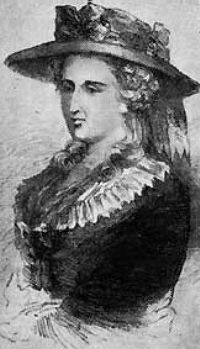Ann Radcliffe: Difference between revisions
imported>Jules Grandgagnage (new article) |
imported>Jules Grandgagnage (+Bibliography) |
||
| Line 10: | Line 10: | ||
Ann Radcliffe exercised a great influence on her contemporaries, and "Schedoni" in ''The Italian'' is one of the prototypes of the ''[[Byronic hero]]''. ''The Italian'' was the last book Radcliffe published during her lifetime (although she did go on to produce the novel ''Gaston de Blondeville'' about an unexplained ghostly visitation,<ref>The Routledge Companion to Gothic, edited by Catherine Spooner and Emma McEvoy</ref> which appeared posthumously in 1826. She died on the 7th of February 1823, from respiratory problems probably caused by [[pneumonia]]. | Ann Radcliffe exercised a great influence on her contemporaries, and "Schedoni" in ''The Italian'' is one of the prototypes of the ''[[Byronic hero]]''. ''The Italian'' was the last book Radcliffe published during her lifetime (although she did go on to produce the novel ''Gaston de Blondeville'' about an unexplained ghostly visitation,<ref>The Routledge Companion to Gothic, edited by Catherine Spooner and Emma McEvoy</ref> which appeared posthumously in 1826. She died on the 7th of February 1823, from respiratory problems probably caused by [[pneumonia]]. | ||
== Bibliography == | |||
* ''The Castles of Athlin and Dunbayne'', anonymous (1789) | |||
* ''A Sicilian Romance'', anonymous (1790) | |||
* ''The Romance of the Forest'', first edition ananymous, London (1791) | |||
* ''The Mysteries of Udolpho'', London, G. G. and J. Robinson (1794) | |||
* ''A Journey Made in the Summer of 1794, through Holland and the Western Frontier of Germany, with a Return Down the Rhine: To Which Are Added Obersavtions During a Tour to the Lakes of Lancashire and Westmorland, and Cumberland'', London (1795) | |||
* ''The Italian, or the Confessional of the Black Penitents'', London (1797) | |||
* ''Ode to Terror'' (1810) | |||
* ''The Poems of Ann Radcliffe'' (1810) | |||
* ''Gaston de Blondeville'', London (1826) | |||
== References == | == References == | ||
<references/> | <references/> | ||
Revision as of 17:42, 19 August 2010
Ann Radcliffe (London, 9 July 1764 – 7 February 1823) was an English author, who wrote several successful novels and was a pioneer of the gothic novel.
She was the only daughter of William Ward, an haberdasher, and Ann Oates. When she was twenty three years old she married William Radcliffe, an Oxford graduate and student of law. He gave up his profession for literature, and afterwards became proprietor and editor of the English Chronicle. [1]
She was the author of three extremely popular novels: The Romance of the Forest (1791), The Mysteries of Udolpho (1794) and The Italian (1797). She is credited as the originator of a school of which she was the most distinguished exponent; and none of her numerous imitators approached her in ingenuity of plot, style and fertility of imagination. Anna Laetitia Barbauld, her publisher, said that compared to other authors, Radcliffe's novels showed rare genius. She had a genuine gift for scenic effect. Her favourite 'props' were ruinous old castles, dark, secret passages, vaults, trapdoors and other mysterious scenery where monstrous crimes and supernatural events took place. She perfectly knew how to fascinate her (predominantly women) readers by putting highly emotional characters in these grim surroundings. While her contemporary, the 'male Gothic writer' Matthew Lewis' focuses on the explicit physicality of horror ('The Monk', 1796) Ann Radcliffe - in what has been termed the female Gothic tradition - chooses a different approach and explores the more subtler aspects of terror and the supernatural.
She disliked public notice and suffered from asthma. After The Italian she gave up writing for publication, (rumors went that she was driven mad by the horrors of her own creations) and disappeared from the public eye during the latter years of her life. Both Sir Walter Scott and Miss Christina Rossetti were admirers of her. However, Rossetti had to give up her plan to write a biography of the best-selling novelist of the 1790s for want of any information of her life.[2]
Ann Radcliffe exercised a great influence on her contemporaries, and "Schedoni" in The Italian is one of the prototypes of the Byronic hero. The Italian was the last book Radcliffe published during her lifetime (although she did go on to produce the novel Gaston de Blondeville about an unexplained ghostly visitation,[3] which appeared posthumously in 1826. She died on the 7th of February 1823, from respiratory problems probably caused by pneumonia.
Bibliography
- The Castles of Athlin and Dunbayne, anonymous (1789)
- A Sicilian Romance, anonymous (1790)
- The Romance of the Forest, first edition ananymous, London (1791)
- The Mysteries of Udolpho, London, G. G. and J. Robinson (1794)
- A Journey Made in the Summer of 1794, through Holland and the Western Frontier of Germany, with a Return Down the Rhine: To Which Are Added Obersavtions During a Tour to the Lakes of Lancashire and Westmorland, and Cumberland, London (1795)
- The Italian, or the Confessional of the Black Penitents, London (1797)
- Ode to Terror (1810)
- The Poems of Ann Radcliffe (1810)
- Gaston de Blondeville, London (1826)
